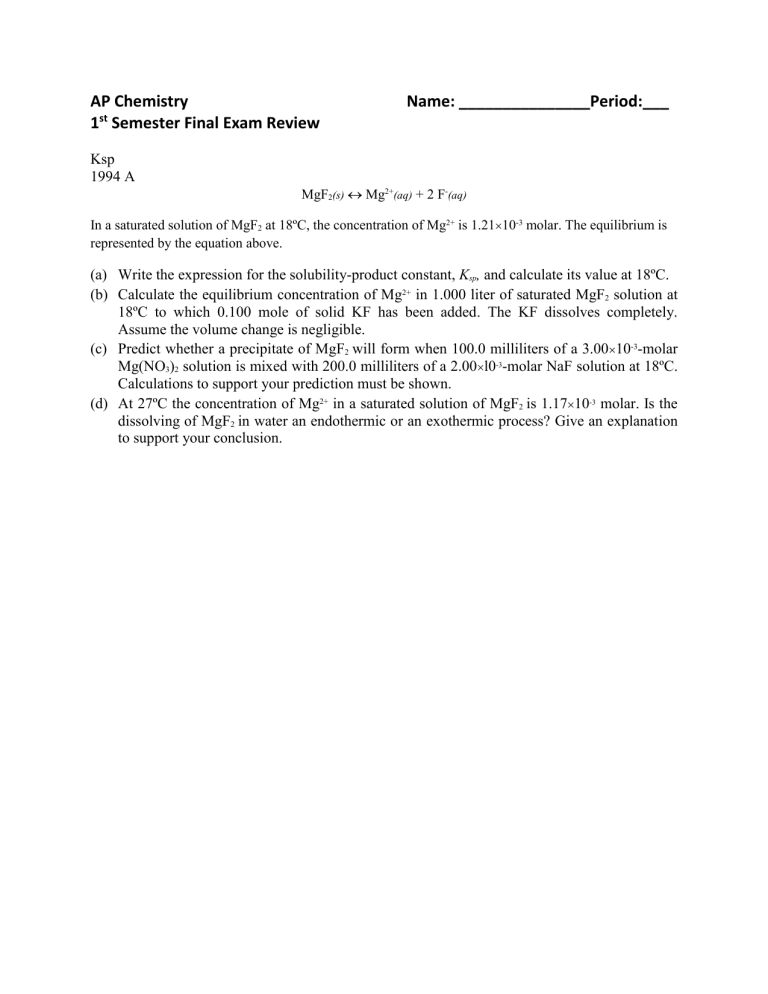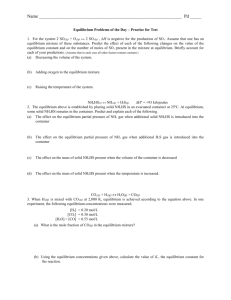Equilibrium - yooschem1314

AP Chemistry
1
st
Semester Final Exam Review
Ksp
1994 A
Name: _______________Period:___
MgF
2
(s)
Mg 2+ (aq) + 2 F (aq)
In a saturated solution of MgF
2
at 18ºC, the concentration of Mg 2+ is 1.21
10 -3 molar. The equilibrium is represented by the equation above.
(a) Write the expression for the solubility-product constant, K sp
, and calculate its value at 18ºC.
(b) Calculate the equilibrium concentration of Mg 2+ in 1.000 liter of saturated MgF
2
solution at
18ºC to which 0.100 mole of solid KF has been added. The KF dissolves completely.
Assume the volume change is negligible.
(c) Predict whether a precipitate of MgF
2 will form when 100.0 milliliters of a 3.00
10 -3 -molar
Mg(NO
3
)
2
solution is mixed with 200.0 milliliters of a 2.00
l0 -3 -molar NaF solution at 18ºC.
Calculations to support your prediction must be shown.
(d) At 27ºC the concentration of Mg 2+ in a saturated solution of MgF
2 is 1.17
10 -3 molar. Is the dissolving of MgF
2 in water an endothermic or an exothermic process? Give an explanation to support your conclusion.
Equilibrium
1998 D
C
(s)
+ H
2
O
(g)
CO
(g)
+ H
2
(g)
Hº
= +131kJ
A rigid container holds a mixture of graphite pellets (C
(s)
), H
2
O
(g)
, CO
(g)
, and H
2
(g)
at equilibrium. State whether the number of moles of CO
(g)
in the container will increase,decrease, or remain the same after each of the following disturbances is applied to the original mixture. For each case, assume that all other variables remain constant except for the given disturbance.
Explain each answer with a short statement.
(a) Additional H
2
(g)
is added to the equilibrium mixture at constant volume.
(b) The temperature of the equilibrium mixture is increased at constant volume.
(c) The volume of the container is decreased at constant temperature.
(d) The graphite pellets are pulverized.
Equilibrium
2000 A Required
1. 2 H
2
S (g)
2 H
2 (g) + S
2 (g)
When heated, hydrogen sulfide gas decomposes according to the equation above. A 3.40 g sample of H
2
S
(g)
is introduced into an evacuated rigid 1.25 L container. The sealed container is heated to 483 K, and 3.72
10 –2 mol of S
2 (g)
is present at equilibrium.
(a) Write the expression for the equilibrium constant, K c represented above.
, for the decomposition reaction
(b) Calculate the equilibrium concentration, in mol
L -1 , of the following gases in the container at 483 K.
(i) H
2 (g)
(ii) H
2
S
(g)
(c) Calculate the value of the equilibrium constant, K c
, for the decomposition reaction at 483 K.
(d) Calculate the partial pressure of S
2
(g)
in the container at equilibrium at 483 K.
(e) For the reaction H
2 (g)
+ Ошибка!
S equilibrium constant, K c
.
2 (g)
H
2
S
(g)
at 483 K, calculate the value of the
Equilibrium
1988 D
NH
4
HS (s)
NH
3
(g) + H
2
S (g)
Hº = +93 kilojoules
The equilibrium above is established by placing solid NH
4
HS in an evacuated container at 25ºC. At equilibrium, some solid NH
4
HS remains in the container. Predict and explain each of the following.
(a) The effect on the equilibrium partial pressure of NH
3
gas when additional solid NH
4
HS is introduced into the container
(b) The effect on the equilibrium partial pressure of NH
3
gas when additional solid H
2
S is introduced into the container
(c) The effect on the mass of solid NH
4
HS present when the volume of the container is decreased
(d) The effect on the mass of solid NH
4
HS present when the temperature is increased.
Equilibrium
1995 A
CO
2
(g) + H
2
(g)
H
2
O (g) + CO (g)
When H
2
(g) is mixed with CO
2
(g) at 2,000 K, equilibrium is achieved according to the equation above. In one experiment, the following equilibrium concentrations were measured.
[H
2
] = 0.20 mol/L
[CO
2
] = 0.30 mol/L
[H
2
O] = [CO] = 0.55 mol/L
(a) What is the mole fraction of CO (g) in the equilibrium mixture?
(b) Using the equilibrium concentrations given above, calculate the value of K c
, the equilibrium constant for the reaction.
(c) Determine K p
in terms of K c
for this system.
(d) When the system is cooled from 2,000 K to a lower temperature, 30.0 percent of the CO (g) is converted back to CO
2
(g)
. Calculate the value of K c
at this lower temperature.
(e) In a different experiment, 0.50 mole of H
2
(g) is mixed with 0.50 mole of CO
2
(g)
in a 3.0-liter reaction vessel at 2,000 K. Calculate the equilibrium concentration, in moles per liter, of
CO (g) at this temperature.
Kinetics
2004 B
The first-order decomposition of a colored chemical species, X, into colorless products is monitered with a spectrophotometer by measuring changes in absorbance over time. Species X has a molar absorptivity constant of 5.00
10 3 cm –1 M –1 and the pathlength of the cuvetee containing the reaction mixture is 1.00 cm. The data from the experiment are given in the table below.
[X]
Absorbance
Time
(M) (min)
?
4.00
10 –5
3.00
10 –5
0.600
0.200
0.150
0.0
35.0
44.2
1.50
10 –5 0.075 ?
(a) Calculate the initial concentration of the unknown species.
(b) Calculate the rate constant for the first order reaction using the values given for concentration and time. Include units with your answers.
(c) Calculate the minutes it takes for the absorbance to drop from 0.600 to 0.075.
(d) Calculate the half-life of the reaction. Include units with your answer.
(e) Experiments were performed to determine the value of the rate constant for this reaction at various temperatures. Data from these experiments were used to produce the graph below, where T is temperature. This graph can be used to determine E a
, the activation energy.
(i) Label the vertical axis of the graph
(ii) Explain how to calculate the activation energy from this graph.
Kinetics/ Equilibrium
2000 D Required
O
3 (g) + NO (g)
O
2 (g) + NO
2 (g)
Consider the reaction represented above.
(a) Referring to the data in the table below, calculate the standard enthalpy change, for the reaction at 25 C. Be sure to show your work.
O
3 (g) NO (g) NO
2 (g)
Standard enthalpy of formation,
H
, ƒ at 25
C (kJ mol -1 )
143 90. 33
(b) Make a qualitative prediction about the magnitude of the standard entropy change, S , for the reaction at 25 C. Justify your answer.
(c) On the basis of your answers to parts (a) and (b), predict the sign of the standard free-energy change, for the reaction at 25 C. Explain your reasoning.
(d) Use the information in the table below to write the rate-law expression for the reaction, and explain how you obtained your answer.
Experiment
Number
Initial
[O
3
] (mol
L
-1
)
Initial
[NO] (mol
L
-1
)
Initial Rate of
Formation of
[NO
2
]
(mol L
-1
s
-1
)
1
2
3
0.0010 0.0010
0.0010 0.0020
0.0020 0.0010 x
2x
2x
4 0.0020 0.0020 4x
(e) The following three-step mechanism is proposed for the reaction. Identify the step that must be the slowest in order for this mechanism to be consistent with the rate-law expression derived in part (d). Explain.
Step I: O
3
+ NO O + NO
3
Step II: O+ O
3
2 O
2
Step III: NO
3
+ NO 2 NO
2









